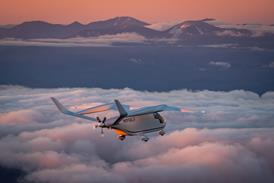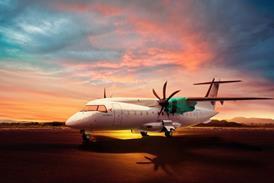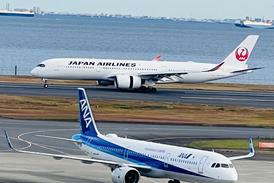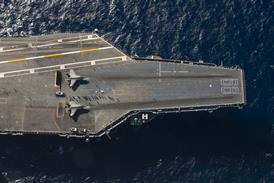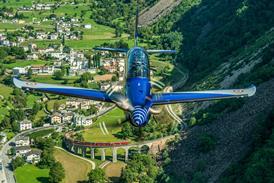The USA is facing significant order cuts, Europe is arguing about project launches, and Russia is in chaos, with procurement at a halt. That is situation normal for military-aircraft manufacturers in the 1990s.
This year's Paris air show will once again be dominated by discussions of problematic programmes, with number-cuts, unreliable partners and political machinations all on the agenda. The Eurofighter EF2000 and the Dassault Rafale will be the focus of much interest.
The French Government has placed an initial batch order for 13 Rafale multi-role combat aircraft, ten for the navy and three for the air force. An additional order for a second batch of 48 aircraft was being lined up for announcement during the show, although the political turbulence in France following the May and June elections could yet lead to this order being delayed or put on indefinite hold.
The EF2000 project has once again been the victim of brinkmanship, with German internal politics causing serious concerns to the other three nations - Italy, Spain, and the UK - in the run up to a much-delayed production-investment (PI) decision.
The two leading adversaries in the latest EF2000 argument - Volker Rühe, the German defence minister and Theo Waigel, the German finance minister - have spent months bickering over the source, if any, at funding for the PI phase of the programme. There are now indications that a solution, perhaps using the early repayment of Airbus finance by Daimler-Benz Aerospace (Dasa) (2/E19), may be emerging. An Anglo-German summit meeting on 6 June between UK Prime Minister Tony Blair and German Chancellor Helmut Kohl was to have had the EF2000 on the agenda.
The latest concern surrounding the programme has been singularly unfortunate in that 1997 has in many ways been encouraging for the EF2000. All seven prototypes are now being flown, with the Alenia-built DA3, the first with the Eurojet EJ200 engines, and the CASA-built two-seat aircraft intended to be at the show.
The EF2000 has also emerged as the only rival to the Lockheed Martin F-16 Block 50N (otherwise known as the Block 60) in Norway's programme to replace its Northrop F-5s. The Saab JAS39 Gripen, McDonnell Douglas (MDC) F-18 and, latterly, the Rafale, have all been discounted.
The irony for Eurofighter is that Dasa is leading the Norwegian campaign to sell the aircraft - a more positive response from the German Government might make Dasa's job easier.
A prolonged, and ultimately successful, behind-the-scenes campaign by British Aerospace (2/C15 Chalet 34/A) saw the EF2000 formally introduced into the United Arab Emirates strike fighter competition. This decision was made public at the IDEX defence show in Abu Dhabi in March, much to the chagrin of Lockheed Martin (Chalet 62/A) and Dassault (2/A16 Chalet 177B/B).
Lockheed Martin has been working hard to have the UAE launch the Block 60 variant of its F-16. It was on the brink of concluding an agreement when political relations between the USA and UAE deteriorated - releasability issues on some aspects of the F-16 Block 60 configuration were in part to blame.
While Lockheed Martin has yet to secure a sale of the F-16 to the UAE, it does appear to have succeeded in sealing a deal to sell around 90 Block 50/52 aircraft to Saudi Arabia as Northrop F-5 replacements.
More significantly for Lockheed Martin, it has also rolled out the first of its F-22A Raptor "air dominance" fighters, developed jointly with Boeing, for the US Air Force. A first flight of the aircraft is imminent. While intended originally as purely an air-superiority aircraft, the F-22 may emerge as the USAF's Replacement Interdictor Aircraft to succeed the Lockheed F-117 and MDC F-15E fighter aircraft.
The Royal Air Force, starting to consider a replacement for the Panavia Tornado GR4 strike aircraft under the Future Offensive Air System (FOAS) requirement, may cast more than a passing eye over F-22 developments.
The Joint Strike Fighter (JSF), another US combat-aircraft project and the only one of the three projects reviewed in the US Quadrennial Defense Review to escape major cuts, will be a focus of interest in Paris. BAe has yet to decide whether it teams with Boeing or Lockheed Martin on the project. The potential UK purchase remains relatively small, even if a JSF variant is chosen to meet FOAS as well as to replace the RN's Sea Harrier F/A2s. BAe's choice of partner has potentially far greater implications in terms of industry restructuring.
Reports of its demise have so far been exaggerated, but the welfare of the European Future Large Aircraft (FLA) will once again be a talking point at Paris (see p46). An FLA policy group meeting is scheduled to take place on 17 June at Le Bourget, and the formal release of a request for proposals is hoped for.
Russia's AVPK Sukhoi (2/E16 Chalet 77/A) and VPK MAPO (5/D2 Chalet 114/B) will also be showing their wares at Paris, keen to try to continue to use even limited export sales to compensate for a lack of domestic orders from the Russian air force.
MAPO's premier combat-aircraft offering remains the MiG-29 Fulcrum - its fifth-generation fighter for the Russian air force, the Article 1.42, having being shelved because of a lack of funds. That aircraft may be wheeled out at Zhukovsky for the MosAero show in August, but the closest it is likely to get to an operational base is the air force museum at Monino.
With the demise of the Article 1.42, and of the MiG-31M Foxhound B, MAPO is looking to extend the life of the basic Fulcrum design for as long as possible. It is now working on a thrust-vectoring aircraft, basedon the MiG-29M project, and dubbed the MiG-35. Intriguingly, the company has also alluded to a fifth-generation light-fighter project, but has so far failed to provide any details.
MAPO will also be showing its MiG-AT contender to replace the Russian air force's Aero L-39 trainer. It is in competition with Yakovlev (5/D2), which is offering the Yak-130, also due to be at the show.
Sukhoi will be displaying its thrust-vector-equipped Su-27M, dubbed the Su-37 by the company. Sukhoi appears to be using the aircraft to test the integration of thrust-vector controls with a digital flight-control system. This work will feed into the Su-30MKI programme for India - all 40 of the aircraft on order may eventually be retrofitted with thrust vectoring. The first canard-equipped Su-30 is nearly complete.
Sukhoi may also bring a pre-production Su-27IB fighter bomber. The strike variant of the Flanker, intended to replace the Su-24 Fencer, appears to be the priority programme for the Russian air force, which, although it would like to acquire the Su-27M, has only limited funding. A further two Su-27Ms only are earmarked to be built at Novosibirsk in 1998. It is possible that elements of the Su-27M programme could be retrofitted to earlier Flanker models.
Given the parlous state of affairs within its home market, Sukhoi is keen to build on its export successes with the Flanker. It has garnered orders from China, India and Vietnam, and, perhaps optimistically, it harbours ambitions of selling a thrust-vector-equipped Su-27 derivative to South Korea.
MDC, with a development of the F-15E, and possibly Lockheed Martin, with an F-22 variant, are more likely to win this business. The EF2000 and the Rafale will also be considered.
Another Soviet-era fighter on display at the show will be an upgraded variant of the venerable MiG-21 Fishbed. Israeli avionics specialist Elbit is upgrading the aircraft for the Romanian air force, with Romanian company IAR Brasov also involved.
Elbit and sometime-competitor Israel Aircraft Industries (IAI) (Chalet 1A/A) are looking to build on their respective successes in the upgrade market. IAI has also carried out MiG-21 upgrade projects, and like Elbit, it is now looking to offer similar packages for the MiG-23/27 Flogger and Su-22 fitter. Both also offer F-5 upgrades.
Another aircraft programme building on Israeli know-how, the Chinese F-10, will not be on display, but attendees will be hoping that those elements of China's aerospace industries which do turn up will be able to provide some insight into the status of several combat aircraft programmes. The Chinese air force has a major re-equipment programme under way, with the Su-27 Flanker having already entered service, while the F-10 and FC-1 fighter programmes and the FB-7 fighter bomber remain in the development phase.
Another point of discussion in the military-transport arena will be the Ukrainian Antonov An-70 propfan-powered tactical airlifter. Antonov (5/B2) was hoping to bring the aircraft to Le Bourget, but the second prototype has clocked up only a limited number of flight hours so far. The first prototype was lost in a fatal crash early in the flight-test programme.
Antonov is competing with Tupolev, offering the yet-to-be-built Tu-330, for a Russian air force military-transport requirement. It remains doubtful, however, whether the air force can afford to fund even a limited procurement.
With the absence of the An-70, there will be no be new-airframe military aircraft to be seen - a clear reflection of the defence slowdown in the 1990s. Despite this, there will be more than enough issues, practical and political, to keep the combat-aircraft community entertained.
Source: Flight International

